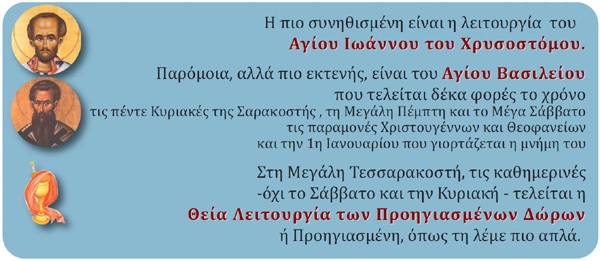Types of Liturgy
20 Οκτωβρίου 2016

From the first days after Christ’s Ascension, the Apostles celebrated the Sacrament of the Divine Eucharist, because they wanted very much to remember Him and to feel that He was close to them. Every day they had an assembly where they sang hymns, recalled events of His life, the miracles, His words and, in particular His Passion and Resurrection. Afterwards, they’d repeat the words He’d given them at the Last Supper, they’d bless the bread and wine and then all of them would partake. Gradually, certain hymns were added, together with particular prayers, and the Liturgy as we know it today was formed.
For centuries now, three types of Liturgy have been established in the Orthodox Church.

The most common is the Liturgy of Saint John Chrysostom.
Similar, but longer is the Liturgy of Saint Basil, which is celebrated ten times a year: on the five Sundays in Great Lent; on Great Thursday and Great Saturday; on the eve of Christmas and Epiphany; and on January 1, when we celebrate his memory.
On weekdays in Great Lent- not Saturdays and Sundays, which aren’t fast days- we celebrate the Divine Liturgy of the Presanctified Gifts, or, more simply, the Presanctified.
On 23 October, when we celebrate the memory of Saint James, the Brother of Our Lord and first Bishop of Jerusalem, the Divine Liturgy of Saint James is celebrated in many churches.
The Divine Liturgy is usually celebrated in the morning. It can, however, take place in the evening (Presanctified) or at night, at a Vigil.
The requirements for the service are: the Holy Altar, the sacred vessels, the vestments of the priest and the Precious Gifts, that is the leavened bread (i.e made with yeast) and the red wine. The Divine Liturgy cannot be held in secret, that is with nobody else present except the celebrant. The presence of the faithful is an absolute requirement, even if it’s only one person, who may act as the choir.





